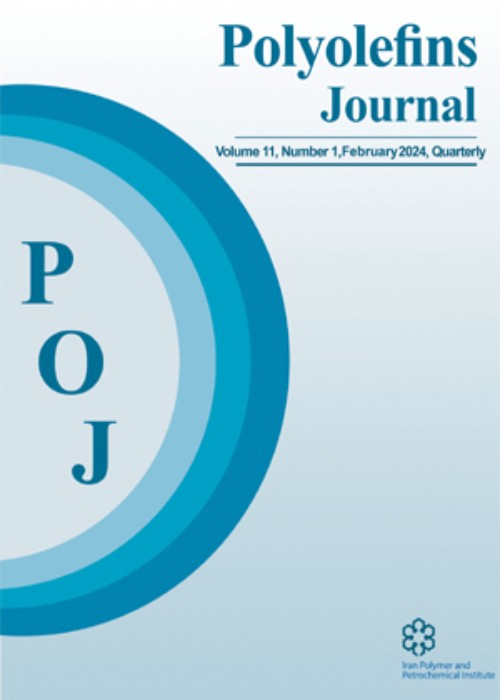فهرست مطالب

Polyolefins Journal
Volume:6 Issue: 2, Spring 2019
- تاریخ انتشار: 1398/03/11
- تعداد عناوین: 6
-
-
Pages 107-1161-Pentene, respectively 1-hexene, were reacted with 13 homogeneous metallocene catalysts to give linear oligomerization products, predominantly dimers, with selectivities above 90%. The product distributions of the codimerization reactions of 1-pentene with 1-hexene reflected a binomial behaviour. Therefore, the ratio for dimers is 1:2:1 (C10:C11:C12) while the trimers (pentadecenes up to octadecenes) show a proportion of 1:3:3:1. By changing the ratio of the 1-pentene/1-hexene mixture, the binomial distribution switched to the side of products of the higher concentrated monomer. Even when using methyl branched olefins, the binomial product distribution could be observed. Alkenes with an internal double bond could not be dimerized under these conditions. The reactions with olefins containing a methyl group in β-position, a tert-butyl group or a neopentyl group failed. Addition of appropriate additives like tributylphosphine or aluminum powder raised both the activities and the selectivities for dimers, which means that the fraction of undecenes obtained from the codimerization reactions of 1-pentene and 1-hexene increased.Keywords: Unbridged metallocene catalysts, homogeneous olefin oligomerization, homogeneous co-oligomerization of olefins, heterogeneous oligomerization of olefins, influence of additives
-
Pages 117-126The new highly active supported vanadium-magnesium catalyst (VMC) has been studied in α-olefin (1-butene, 1-hexene)/ ethylene copolymerization in the presence of hydrogen. Data on the effect of α-olefin/ethylene ratio in copolymerization on the content of branchings in copolymers, kinetic profile, copolymer yield, molecular weight and molecular weight distribution of copolymers have been obtained. It was found that both α-olefins are effective chain transfer agents in the ethylene-α-olefins copolymerization. The copolymerization ability of VMC is much higher than that of the well known titanium-magnesium catalysts. It was found that the use of optimal conditions of ethylene/α-olefin polymerization on the VMC catalyst makes it possible to obtain copolymers with a high yield (10-16 kg gcat-1 cat for 2 h) the copolymers having broad and bimodal MWD. Data on the branchings distribution in copolymers prepared with VMC catalyst have been obtained via fractionation of copolymers on the fractions with narrow polydispersity (Mw/Mn ≈ 2). Quite a uniform distribution of branchings over fractions with different molecular weight was found in distinction to inhomogeneous distribution of branchings in copolymers produced over the well known supported titaniu-magnesium catalyst.Keywords: Polyethylene (PE), supported vanadium-magnesium catalys, t molecular weight distribution, effect of comonomer, reactivity ratio
-
Pages 127-138In this work, the effect of hexyl branch content on thermal behavior of a fractionated ethylene/1-octene copolymer with emphasis on high temperatures was investigated. The ethylene/1-octene copolymer was carefully fractionated to different fractions with homogenous hexyl branch (HB) content by preparative temperature rising elution fractionation (P-TREF) method. The P-TREF fractions were thermally analyzed via differential scanning calorimetry (DSC), thermogravimetric analysis (TGA) and evolved gas analysis (EGA). The P-TREF profile showed a short chain branch distribution (SCBD) of around 1.24. A linear relationship between P-TREF elution temperature (ET) and methylene sequence length (MSL) was presented. The DSC curves exhibited a monolithically increase in melting temperature (Tm) as well as crystallization temperature (Tc) by decreasing short chain branch (SCB) content. The calculated values of lamellae thickness suggested a linear function of SCB content and Tm. The TGA studies of P-TREF fractions depicted a two-stage thermal degradation behavior: pre-degradation and main degradation stages. Tmax for both pre-degradation and main degradation stages was increased for fractions with less hexyl branch content. As an interesting point the pre-degradation stage was found more intensified for more linear fractions. The concentration of main products was found to be affected by the content of hexyl branches using Py-GC-MS.Keywords: thermal behavior, ethylene, 1-octene copolymer, hexyl branch content, thermal degradation
-
Pages 139-150Three polypropylene samples (1-3) were synthesized with a 4th generation Ziegler-Natta catalyst in the presence of cyclohexyldimethoxymethylsilane (donor c), dicyclopenthyldimethoxysilane (donor d) and diisopropyldimethoxysilane (donor p), respectively, as external electron donors. The physical properties of the synthesized polypropylenes were determined. For samples 1 to 3, Successive self-nucleation and annealing (SSA) and Fourier transform infrared spectroscopy (FT-IR) analyses indicated that the relative content of the fraction with high isotacticity and regularity in conformational structure decreased in contrast with the fraction of low isotacticity and low uniformity in stereo-defect distribution from sample 1 to 3. The results demonstrated that the longer the isotactic sequence length and the less uniform the stereo-defect distribution, the greater the conformational order. Deconvolution of the molecular weight distribution curves indicated that the stability of the active centers increased from samples 1 to 3, but the participation of stereo-specefic active centers in the polymerization decreased. DMA tests showed that samples 3 and 1 had the highest damping ability and storage modulus, respectively.Keywords: External electron donor, Melting point, Polypropylene, Stereo-defect distribution, Ziegler-Natta catalyst
-
Pages 151-158High impact polystyrene (HIPS)/corn starch blends were prepared in presence of glycerol as a plasticizer via melt extrusion process by a twin-screw extruder. The novelty of this work is first, because of the use of pre-gelatinized corn starch as modified one and second, the procedure of making blends by extruder which makes it ease of access and also industrially possible. The blends were then characterized by scanning electron microscopy (SEM) to visualize morphology of blends and dispersion of starch in HIPS matrix, soil burial test (SBT) to investigate of blend biodegradability by measuring weight loss of samples, Izod impact strength test to evaluate of impact properties, melt flow index (MFI), thermo-gravimetric analysis (TGA) and Vicat softening point (VSP) tests to evaluate their thermal properties of prepared blend samples. Results indicated that these properties were affected by the amount of starch and glycerol used for preparation of blends in a way that addition of starch and glycerol led to a faster degradation rate especially in first two weeks, more decomposition stages through TGA, decrease in values of Izod impact strength and VSP. Measurements also showed that higher amount of starch led to decrease in the value of melt flow rate (MFR), although it was increased by addition of glycerol.Keywords: High Impact Polystyrene, Corn Starch, Glycerol, Melt Extrusion, Biodegradation
-
Pages 159-167To apply the nanomaterial as a component in the packaging material structure, in this research, the carboxymethyl cellulose (CMC)/polyvinyl alcohol (PVA) film were prepared with three levels of nanoclay particles (0.5, 1 and 3%) using solution casting evaporation method. The incorporation of nanoclay on mechanical, water vapor permeability, and oxygen barrier properties of CMC/PVA-based film was investigated. The best result was obtained through the nanocomposite film contain 3% nanoclay. In the next step, the CMC/PVA/nanoclay films were employed for walnut packaging. After 90 days storage in the environmental condition, the optimum result was found through the nanocomposite film with 3% nanoclay in terms of oil content, moisture content, acidity and peroxide indexes of walnuts. According to the overall results, the reinforcement of CMC/PVA film with 3% nanoclay could be introduced as a good candidate for the development of high barrier food packaging material against the diffusion of water vapor and oxygen permeability.Keywords: Film, Nanocomposite, Packaging, Properties, Walnut


